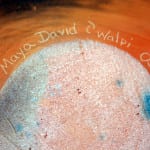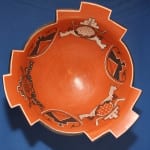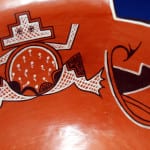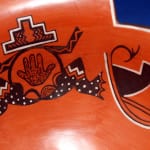If pot 2010-10 is a Zuni pot that looks Hopi, this bowl by Maya David is the reverse: a Hopi pot that looks Zuni. Stepped edge bowls are known at Hopi, but they are unusual. (See 2000-01, 2005-17 and 2005-18.) Such bowls are frequently made at Zuni. Frogs are a common motif at Zuni; except for the frog signature of the Navassie family, they are largely unknown as a design element at Hopi. (But for a Hopi pot with appliquéd Zuni frogs by Daisy Hooee, see pot 2011-13.) Made of yellow clay that fires red, bowl 2010-26 is unusually light and thin for a Hopi pot. It has an undecorated exterior with a smudges from outdoor firing.
This is an extraordinary pot. I have not seen anything remotely like it from Hopi.
The edge of the bowl is painted black. Below it on the interior is a white line that highlights the stepped form. The internal design of the bowl reflects the stepped edge of the bowl, tying form and design together and giving the pot a centered presence. Under each of the three stepped edges of the bowl on the interior are stylized frogs. The stepped form of the heads of the frogs mirror the physical edge of the bowl above them. Although similar in form, each frog is internally unique. One is black, has a handprint in its center, and is decorated with white spots. A second frog is mostly solid white with black tadpoles on a white background in its center. The final frog is constructed mostly with crosshatched white lines and has white tadpoles painted on the red surface of the pot. Between the frogs are three stylized images of prayer bowls like bowl 2010-26. As a viewer’s eye scans this pot, the painted stepped bowl design and the stepped heads of the frogs reflect the physically stepped edges of the bowl: design and crenellated form play off each other to give the bowl unity and grace.
I had not heard of Maya David before I saw pot 2010-26.
On 12/9/10 I called Brandon at Ancient Nations Gallery, the original seller of the piece, and asked about Maya. Brandon said:
“(Maya) was in her early 20’s when she made your pot. Her work is exceptional and always well done. We did not get much from her. I got the sense that she did not see pottery making as her major livelihood but rather a sport to do when she had free time.”
Several months later Ancient Nations Gallery listed a canteen by Maya David and described her as:
“…one of the new, young potters who is blending a variety of techniques and influences to create a style that is all her own. Her teachers include Loren Ami and many others. She is the daughter of Janet David, of Gentle Rain Designs, and she is the grand-daughter of Les David, the well-known Katchina carver…..”
In March of 2015 Monica Nuvamsa and Colleen L.ucero visited Houston to assess my pottery collection for The Hopi Foundation. I mentioned my uncertainly about pot 2010-26 and its maker to Monica. She punched a button on her cell phone and said “Why don’t you ask Maya?” We had a gentle and informative conversation.
She is Tobacco clan.
She remembered bowl 2010-26 clearly. “A larger pot than I usually make.” She intended to make a sharply flared vessel “of very different shape” out of the yellow clay, but “The pot came to be on its own. Something dropped on it and it took that shape,” ” she told me. Maya removed all the cracked pieces and found that three large rim segments of the pot were still intact.
Maya’s father is Zuni and she was familiar with the Zuni prayer bowls with four directional elements. She had recently toured the pottery collection at the Museum of Northern Arizona. Taking inspiration from these sources, she helped the pot shape itself into a prayer bowl with three (instead of the usual four) stepped directional rim forms. The yellow clay (fires red) allowed for thin walls. The design “sort of announced itself,” she noted.
She said, her pottery making was influenced by her mother’s father, Leslie David, a well-known Katchina carver. His mother died when Leslie was very young, but he remembered how she fashioned pottery and showed his granddaughter Maya. “He was the first one to show me how to shape and mold the clay,” Maya said.
For a while she dated Lowell Cheresposy, the grandson of Dextra and through him became friends with Loren Ami. Loren showed Maya how to select the manure and how to fire pots. “But most of what I know about pottery, I learned from just doing,” she says.
Maya’s family is from Walpi, First Mesa but her younger years were spent in Utah and then her family moved to Eastern TN during her high school years. She has some unfinished pots but has not worked on them in a long time.
This pot is one of a group of pots that were part of a 2,400-item Southwest pueblo pottery collection that was assembled by Rutt Bridges of Denver, CO over a period of about 14 years. His sister, Kathleen Hoff, is helping her brother sell the collection. In 2009, Kat sent me two CDs with information about Hopi pots in the collection. During 2010, over a period of months Kay sent me additional photographs of about 200 Hopi and Hopi/Tewa pots from the collection.






